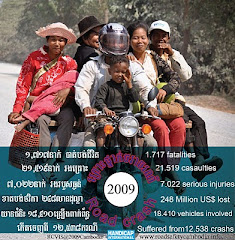CALL FOR ACTION
ROAD SAFETY IN THE WESTERN PACIFIC REGION
Road crashes cause approximately 300 000 deaths (a quarter
of the world’s total of 1.2 million deaths). This amounts to more than 800 people dying every
day in the Region. Millions more are injured and are permanently disabled. In addition to the
human suffering, road traffic crashes place a huge burden on national economies. More than
90% of road traffic deaths occur in low- and middle-income countries. As most countries in the
Region experience economic growth and motorization, road traffic injuries are expected to
increase in the future.
Background• About 300 000 people die each year on roads in the Western Pacific Region.
• Millions more suffer nonfatal injuries.
• The threat of road traffic injuries to growth is increasing.
• There has been no regional assessment of road safety.
• This report is the first assessment of the status of road safety in the Region.
Key findings• Low- and middle-income countries have higher road traffic fatality rates (15.6 and 16.9
per 100 000 population, respectively) than high-income countries (7.3 per 100 000).
• Death rates have been declining over the last four to five decades in most high-income
countries in the Region.
• More than half of those who die in road crashes are pedestrians, cyclists or users of
motorized two-wheelers–collectively known as “vulnerable road users”.
• The proportion of vulnerable road users to total road fatalities is highest (70%) in lowincome
countries in the Region compared to middle-income and high-income countries.
• There is a lack of policy measures that allow road users to walk and cycle safely.
• Measures to improve the quality of and access to public transport are limited.
• Only 19 participating countries have helmet laws that are comprehensive in scope (i.e.
require both drivers and passengers of motorized two-wheelers to wear helmets on all
roads and regardless of engine type).
• Almost all countries have some kind of national drink–driving law, yet only eight countries
have a law that uses a blood alcohol concentration (BAC) limit of less than or equal to
0.05g/dl, as recommended in the World Report on Road Traffic Injury Prevention.
• Of 17 countries in the Region that have speed limits on urban roads of less than or equal
to 50km/h, only four countries allow local authorities to reduce national speed limits.
• Of 18 countries reporting national or subnational seat belt laws, only eight countries
require all vehicle occupants in front and rear seats to wear seat belts.
• Only 11 countries have legislation about the use of child restraints.
• Enforcement for all of these risk factors generally is lax.
• While 23 countries report having a lead agency for road safety, only nine countries have
a national road safety strategy that was endorsed by the government, sets targets and
funds the strategy.
• Huge gaps remain in the quality and coverage of the data that countries collect on road
traffic injuries.
• Underreporting of road traffic fatalities remains a big problem in many countries. The
situation is worse with regard to nonfatal injuries.
• The lack of standardization of terminology among sectors within a country and between
countries limits comparability of data.
• Only nine countries indicated that they had data on fatal and nonfatal road traffic injuries,
estimates of the cost to their economy and data on monitoring and evaluation indicators
such as the rates of helmet use and wearing of seat belts.
Key recommendations for governments• The needs of all road users should be taken into consideration when making policy
decisions that impact on road safety.
• Vulnerable road users should be given due consideration when decisions are made
about road design and infrastructure, land use planning and transport services.
• Public transportation should be strengthened both in urban and rural areas in order to
reduce exposure.
• Member states should enact comprehensive laws that require all road users to be
protected through the enforcement of speed limits that are suitable for the type and
function of the road, the stipulation of blood alcohol concentration limits that help reduce
drink-driving and the use of helmets for motorcyclists and seat belts and child restraints
for vehicle occupants. These occupant protection devices should conform to national or
international standards. Existing legislation should be reviewed and amended to conform
to good practices that are based on sound evidence of effectiveness.
• Enforcement of all road safety laws should be improved. Enforcement efforts must be
well-publicized, sustained and implemented through the use of appropriate measures
and penalties for infringement.
• Collaboration among different sectors involved in collecting and reporting road traffic
injury data should be encouraged. This involves improving data linkages among police,
transport and health services, standardization of case definitions and increasing the
human capacity to undertake data collection.
• Institutions responsible for road safety should have the necessary human and financial
resources to act effectively. The formulation and endorsement of a national strategy with
realistic targets and earmarked funding for implementation would help achieve longterm
road safety goals.
Source: Regional status report 2009



